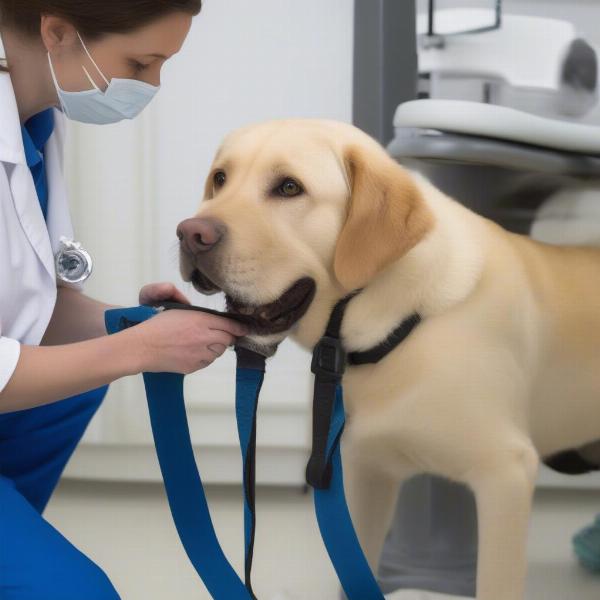Hip dysplasia is a common but debilitating joint condition that can significantly impact a dog’s mobility and quality of life. A hip brace for dogs with hip dysplasia can offer support, reduce pain, and improve overall function. Understanding the benefits, types, and proper use of these braces is crucial for any owner dealing with this challenging diagnosis.
Understanding Canine Hip Dysplasia and the Role of Braces
Canine hip dysplasia is a genetic condition where the hip joint doesn’t develop correctly, leading to instability and arthritis. This can cause pain, lameness, and difficulty walking, running, or jumping. While surgery is sometimes necessary, conservative management options like using a hip brace can significantly improve a dog’s comfort and mobility, especially in mild to moderate cases. Hip braces provide support to the joint, reducing inflammation and pain by stabilizing the hip and limiting abnormal movement. They can also help improve muscle strength and function in the affected leg.
Types of Hip Braces for Dogs
There are various types of hip braces available, each designed for specific needs and stages of hip dysplasia. Some common types include:
- Compression Braces: These provide gentle compression and support to the hip joint, reducing inflammation and pain.
- Support Braces: Offer more substantial support and stability, often incorporating straps and rigid components to limit movement.
- Custom-Made Braces: Designed specifically for the individual dog’s anatomy, providing the best possible fit and support.
Choosing the Right Brace for Your Dog
Selecting the right brace is crucial for its effectiveness. Factors to consider include the severity of the dysplasia, your dog’s size and breed, activity level, and overall health. Consulting with your veterinarian is essential to determine the most appropriate type of brace for your dog’s specific needs. They can assess your dog’s condition and recommend the best course of action.
Using and Caring for a Dog Hip Brace
Proper use and care of the brace are vital for maximizing its benefits and preventing complications. Ensure the brace fits correctly and doesn’t restrict blood flow or cause discomfort. Follow your veterinarian’s instructions carefully on how to apply, adjust, and clean the brace. Regular cleaning helps prevent skin irritation and maintains the brace’s effectiveness.
 Veterinarian Fitting a Dog with a Hip Brace
Veterinarian Fitting a Dog with a Hip Brace
Combining Bracing with Other Therapies
Hip braces can be highly effective when used in conjunction with other therapies, such as physical therapy, medication, and weight management. Physical therapy can help improve muscle strength and range of motion, while medication can manage pain and inflammation. Maintaining a healthy weight is crucial for reducing stress on the hip joint.
“Hip braces are a valuable tool in managing hip dysplasia, but they are most effective when combined with a comprehensive treatment plan,” says Dr. Emily Carter, DVM, a certified canine rehabilitation specialist.
Conclusion
A hip brace for dogs with hip dysplasia can significantly improve a dog’s quality of life by reducing pain, improving mobility, and supporting the hip joint. Choosing the right brace, using it correctly, and combining it with other therapies are essential for achieving the best possible outcomes. By working closely with your veterinarian and following a comprehensive treatment plan, you can help your dog live a more comfortable and active life despite hip dysplasia.
FAQ
-
How long can a dog wear a hip brace? This depends on your veterinarian’s recommendations and your dog’s individual needs. Some dogs may wear the brace for a few hours a day, while others may benefit from wearing it for longer periods.
-
Can a hip brace cure hip dysplasia? No, a hip brace cannot cure hip dysplasia. It is a management tool that can help alleviate symptoms and improve function.
-
Are there any side effects of using a hip brace? Potential side effects can include skin irritation or pressure sores if the brace doesn’t fit correctly.
-
How do I know if my dog needs a hip brace? Consult with your veterinarian. They can diagnose hip dysplasia and determine if a brace is appropriate for your dog’s condition.
-
How much does a dog hip brace cost? The cost varies depending on the type of brace and whether it is custom-made.
-
Can a hip brace be used for other leg injuries? Yes, some types of braces can be used for other leg injuries, but it’s essential to consult with your veterinarian to determine the appropriate type of brace.
-
Can puppies wear hip braces? Yes, puppies with hip dysplasia can sometimes benefit from wearing a brace.
ILM Dog is a leading international online resource dedicated to providing expert advice on dog care, health, and wellbeing. We cover a wide range of topics, from breed selection and nutrition to training and health management. Our mission is to empower dog owners with the knowledge and resources they need to provide the best possible care for their canine companions. We offer expert insights on choosing the right hip dysplasia braces for dogs and other essential products. For personalized advice or inquiries regarding leg braces for dogs with hip dysplasia and dog brace for back leg, contact us at [email protected] or call us at +44 20-3965-8624. ILM Dog – Your trusted partner in dog care.